The Sino-Sweden Archaeology Forum in Beijing 2005
An Opening Ceremony of Sino-Sweden Cooperation on Archaeology in the 21st Century
------the Sino-Sweden Archaeology Forum in Beijing
Scholars of the IACASS and nine archaeologists from the Department of Archaeological Excavations, Swedish National Heritage Board leaded by chairman Bengt Johansson had enjoyed two exciting days during the Sino-Sweden Archaeology Forum hold in Beijing on Sept. 26. After a short opening ceremony, 10 IACASS archaeologists and 8 Swedish archaeologists had given 20 lectures to nearly 100 audiences in the two days.
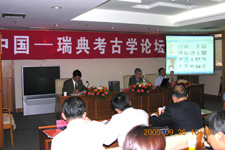
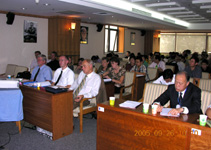
Professor Liu Qingzhu, director of the IACASS gave the first lecture titled “New development and New Perspectives of the Archaeological Researches on Early Capital Cities in China”. Based on the latest discoveries from ancient capital cities including Taosi, Wangchenggang, Guchengzhai, Xinzhai and Erlitou, he argued that the settlement hierarchy system recorded in ancient text – the “cheng (walled city with ancestral temples) – yi (large settlement without ancestral temples) – ju (common settlement) system” is a useful framework for our research on the emergence of early states in China, and how to archaeologically distinguish the capital of a wangguo (the early state) from the cheng of a bang (the pre-state complex society) is a topic deserving earnest study in the near future.
In the second lecture – Contract Archaeology in Sweden - An Introduction, Dr. Lars Ersgård, deputy director/ associate professor of the Department of Archaeological Excavations gave the audiences an outline of Swedish contract archaeology today, its organization and the involved archaeological institutions.
The third lecturer, professor Wang Wei, vice director of the IACASS, discussed Some Problems on the Origin of Chinese Civilization, including ecological and geographic contexts, premises and mechanism of the emergence of Chinese civilization. He argued that the early state in China was in fact the patriarchal clan polity which was based on both blood relation and territory relation. Interaction (conflicts, communication, amalgamation) among different social groups, he said, was one of the main dynes of the formation and development of Chinese civilizations.


Dr. Anders Kaliff, with his lecture Swedish Pre-history – an introduction ended the morning discussion. He gave a brief overview of the prehistory of Sweden, mainly based on results from archaeological excavations of recent years. The development of different districts and central areas was emphasized.
Professor Bai Yunxiang, vice director of the IACASS, with his lecture Origin of Bronze and Iron in China, started the afternoon discussion which focused on special topics. Bai suggested a double-centers model of the origin of bronzes in China – the northwestern China and the central plains region might had their own tradition of bronze manufacture. According to Bai, two systems of early iron objects can be archaeologically recognized in China. One is the Northwestern System represented by the iron works found in Xinjiang and adjacent areas. The other is the Central Plains System represented by the iron works found within the conjunctive area of Henan, Shaanxi and Shanxi.
Dr Lena Grandin also talked about archaeometallurgy. Her lecture Archaeometallurgy – archaeological and analytical perspectives was a brief introduction of archaeometallurgy researches at the National Heritage Board in Sweden. A group of archaeologists and geologists there had developed methods for identification and characterisation of constructions and material, and documentation and sampling in field. Their analytical work comprises detailed studies in microscope of cross sections, and several qualitative and quantitative chemical analyses of single phases or bulk samples.

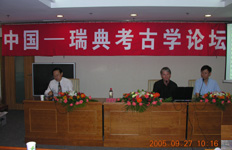
The following three lectures were all about settlement archaeology.
Dr. Lars Ersgård, with his lecture Towns and central-places during 2000 years – a survey of archaeological research in Sweden, aimed to give a survey of current archaeological research in Sweden upon the development of towns and central-places during the Iron Age and historical times. According to him, this urbanization process extends over three main phases
Central-places during the Iron Age – 0-1000 AD
The medieval towns during early historical times – 1000-1500 AD
The towns during modern times – 1500 AD – present times
Professor Xu Hong’s lecture The settlement archaeological study of the Erlitou site and the peripheral region introduced results of the latest excavations at the Erlitou site and field surveys in its surrounding areas. Coring work shows that the 300 ha site has a central palace city surrounded by the wall and wide roads. The surveys covered an area of 638 sq km, and recorded 174 new sites. Settlement pattern study indicates a clearly development of settlement hierarchy which finally leaded to the emergence of the early state in this area.
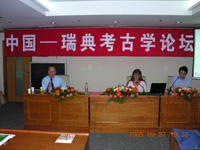
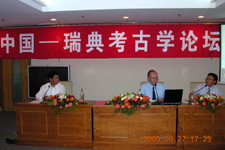
Professor Chen Xingcan’s lecture Development of Social Complexity in the Heartland of Chinese Civilization: Yiluo Region Settlement Patterns talked about another large scale field survey project in the Yiluo River valley. This project is an internationally collaborative and interdisciplinary archaeological program to monitor changes in settlement pattern from early Neolithic to the full development of states (c. 6500-200 B.C.) in the Yiluo the heartland of Chinese civilization. Full-coverage regional survey is integrated with geoarchaeological investigations, ethnobotanical studies, and lithic and ceramic analyses. The data generated from these investigations allow archaeologists to test theoretical propositions regarding the emergence and development of social complexity.
Dr. Magnus Andersson’s lecture The West Coast Line Project – Presentation of a large-scale project give the audiences a good example of how contract archaeology was conducted in Sweden.
On the second day, the forum focused on archaeological sciences.
Professor Yuan Jing restarted the forum with his lecture New Development of Research on the Origin of Chinese Domestic Animals. His study shows the origin of domestic animals in China’s Neolithic period appears more than 1000 years later than the development of pottery making and crops planting. By now evidences of domestic pigs (Suscrofa Domesticus) have been found at several sites dating to about 8000 BP. Bones of horses used in ritual sacrifices suddenly appeared in a great at the late Shang Yinxu site, probably as a result of foreign culture spread.
Dr. Magnus Andersson’s lecture Domestication and the first Neolithic concept argued that the archaeological material in Scania in the southern part of Sweden unequivocally suggests that the transition from the Late Mesolithic Ertebölle culture to the earl Neolithic Funnel Beaker culture was not a great upheaval. It seems as if the really great changes to society did not come until later in the Early Neolithic. It is obvious that the terms Mesolithic and Neolithic, referring to different cultures with distinct economies and social organization, should not be over interpreted. The sharp boundary drawn between the two periods is partly a product of these terms.
In his lecture Domestication of Millets--New Data of Paleoethnobotany, Dr. Zhijun Zhao showed the exciting discoveries from the Xinglonggou site, located at the upper Liao River area, eastern Inner Mongolia. A tremendous amount of charred millet grains, including both broomcorn millet and foxtail millet, were discovered, and dated by AMS to about 8000 years ago. The morphological analysis indicated that these millet grains have more primitive characteristics, such as being smaller in size and elongated in shape, suggesting that the crops were probably undergoing domestication in the locale.
Dr. Per Lagerås, with his lecture Combining archaeology with palaeoecology, reminded the audiences that archaeology and palaeoecology are well-established scientific disciplines in Sweden and the collaboration between them has a long tradition. He presented several interesting examples to show how palaeoecological analyses of peat sequences, soil profiles, and archaeological contexts, give us new insights into Neolithic burial customs, Iron Age agriculture, and the establishment and abandonment of a medieval farm.
Dr. Caroline Arcini, a specialist in Osteology/ Physical Anthropology, gave the lecture Reconstructing daily life in past populations. Through some concrete examples from her 20 years experience, she demonstrated to the audiences what anthropology could offer. The ravaging of epidemics, social care and responsibility, documentation of periods of famine, changes in diet, accidents and violence, combat wounds but also mutilation as a personal decoration are some of the traces made visual through anthropological analysis.
Zhang Jun, a female physical anthropologist of the IACASS, then lectured under the title Human Remains from Xinglongwa Site, Aohanqi, Inner-Mongolia. Her study found a number of diseases on Xinglongwa human skeletons, including osteoarthritis, ankylosis, button osteoma, and other types of disease caused by innutrition like porotic hyperostosis and osteoporotic. Among those diseases that can be identified from analyses of the remains, diseases related to vertebra were most common, especially to the lumbar.
In her lecture Archaeological Conservation in Sweden – Ethical considerations in theory and practice, Monika Fjaestad, emphasized that the Swedish tradition of archaeological conservation could be concluded in the sentence – “Less is more”.
Lars-Inge Larsson pointed out in her lecture Digital archaeology, the Swedish way that an archaeological project creates a lot of information of different kinds. Hence the National Heritage Board constructed the Intrasis system which makes it possible to handle all information from one project in one easy and effective system. Intrasis is also designed to be flexible, making it possible to adjust the system to current needs or strategies. Since two years back the National Heritage Board has also started a very serious and advanced development in the area of geophysical prospections of archaeological sites.
Jianguo Liu’s lecture GIS-based Research on Regional Archaeology in China was about his recent GIS based study on settlement patterns in different areas. In the buffer area analysis, it is obvious that almost all the settlements just located within the 600 meters buffer area of rivers. The analysis of slope and aspect shows that almost all the settlements located on the slope from 1 to 3 degree, and the distribution of settlements seems to have no relationship with the aspect.
Zhong Jian gave the last lecture Application of magnetic prospecting in field archaeology. His recent work demonstrates a great potential of magnetic prospecting in field archaeology.
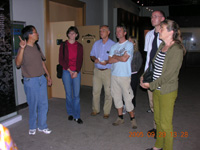
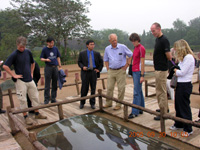
A welcome banquet was hold by the IACASS at an old Beijing style restaurant in the evening of Sept 26. The hosts and guests had some traditional Beijing food which J. Andersson might have had some 80 years ago. Andersson had been mentioned many times during the forum. Everyone believes that it is time to restart Sino-Sweden cooperation on archaeological research. Swedish archaeologists visited the Yangshao site in Mianchi, Henan province after the meeting. The excavation at the site in 1921 directed by Andersson is regarded as the mark of the emergence of modern archaeology in China.

